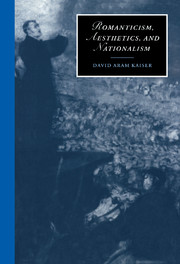Book contents
- Frontmatter
- Contents
- Acknowledgements
- List of abbreviations
- Introduction
- 1 Modernity, subjectivity, liberalism, and nationalism
- 2 The symbol and the aesthetic sphere
- 3 Schiller's aesthetic state
- 4 Symbol, state, and Clerisy: the aesthetic politics of Coleridge
- 5 The best self and the private self: Matthew Arnold on culture and the state
- 6 Aesthetic kingship and queenship: Ruskin on the state and the home
- 7 The aesthetic and political spheres in contemporary theory: Adorno and Habermas
- Notes
- Index
2 - The symbol and the aesthetic sphere
Published online by Cambridge University Press: 22 September 2009
- Frontmatter
- Contents
- Acknowledgements
- List of abbreviations
- Introduction
- 1 Modernity, subjectivity, liberalism, and nationalism
- 2 The symbol and the aesthetic sphere
- 3 Schiller's aesthetic state
- 4 Symbol, state, and Clerisy: the aesthetic politics of Coleridge
- 5 The best self and the private self: Matthew Arnold on culture and the state
- 6 Aesthetic kingship and queenship: Ruskin on the state and the home
- 7 The aesthetic and political spheres in contemporary theory: Adorno and Habermas
- Notes
- Index
Summary
THE LITERARY SYMBOL
In literary criticism of the twentieth century the symbol has been a dominant concept. New Criticism emphasized the literary symbol, and identified it with the dual qualities of uniqueness of expression and multiplicity of meaning. The literary symbol's form was supposed to be uniquely fitted to its content, and its meanings were supposed to be never fully captured or exhausted by substitution or paraphrase. In both English-language and continental literary criticism and theory there has been a strong reaction against the former hegemony and grandiose claims of critical methods based on the symbol. A defining moment in this reaction was Walter Benjamin's attempt to argue for the value of allegory in the face of the hegemony of the symbol:
For over a hundred years the philosophy of art has been subject to the tyranny of a usurper who came to power in the chaos which followed in the wake of romanticism. The striving on the part of the romantic aestheticians after a resplendent but ultimately non-committal knowledge of the absolute has secured a place in the most elementary theoretical debates about art for a notion of the symbol which has nothing more than the name in common with the genuine notion. This latter, which is the one used in the field of theology, could never have shed that sentimental twilight over the philosophy of beauty which has become more and more impenetrable since the end of early romanticism.
- Type
- Chapter
- Information
- Romanticism, Aesthetics, and Nationalism , pp. 28 - 38Publisher: Cambridge University PressPrint publication year: 1999



